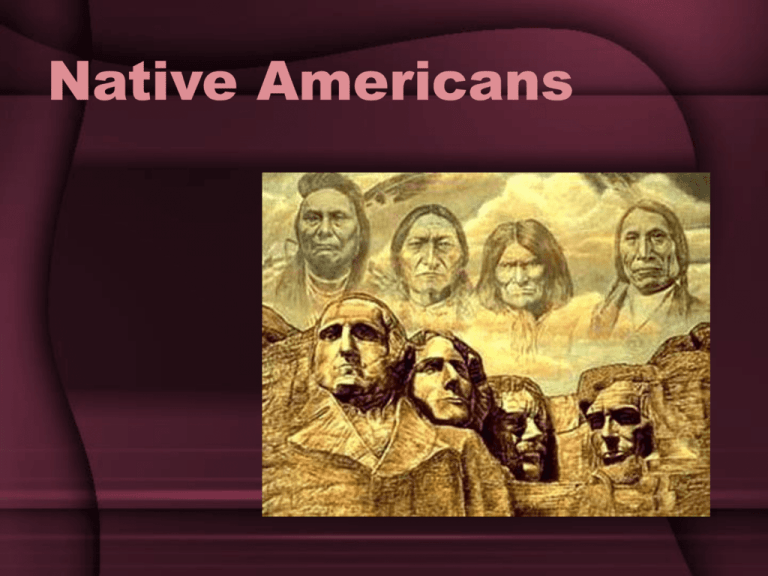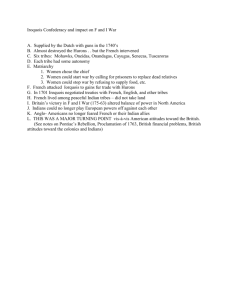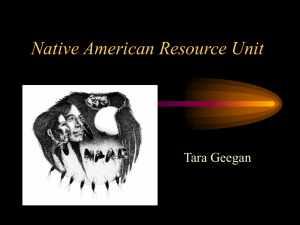Tara Geegan
advertisement

Native Americans Table of Contents • • • • • • • History People Geography Economics Government Citizenship Rights and Responsibilities Social Studies Skills and Methods Native Americans • First Grade • Social Studies Lesson • Author: Tara Geegan HISTORY Websites Lesson Plans for U.S. History http://members.aol.com/MrDonnHistory/Am erican.html National Museum of the American Indian http://www.nmai.si.edu Native American Religion http://nationalhumanitiescenter.org/tserve/ei ghteen/ekeyinfo/natrel.htm HISTORY Websites Lewis and Clark Lesson http://www.oklatravelnet.com/# Making a Tepee http://www.enchantedlearning.com/crafts/na /teepee/ History: Activities Activity 1: • Students will learn about tepees and how Native Americans used them for shelter. Afterwards, the students will make tepees out of paper bags. Activity 2: • Students will create a time line of important events in Native American history. History: Activities Activity 3: • Students will compare and contrast how we get our food today with the methods of food that Native Americans previously used. Activity 4: • Read Annie and the Old One by Miska Miles and compare Annie’s world to Native American’s life long ago. History: Activities Activity 5: • Students will discuss the practices of different tribes and create a Venn Diagram to display the differences and similarities of two (Example: Cherokee and Seminole) PEOPLE IN SOCIETIES Websites Native American Baskets http://nativeamericans.mrdonn.org/baskets. html Dream Catchers http://www.mrdonn.org/nativeamericans.ht ml#dreamcatchers PEOPLE IN SOCIETIES Websites Making a Rain Stick http://artsedge.kennedy-center.org Types of Canoes http://nativeamericans.mrdonn.org/canoes. html Collaborative Thematic Units http://www.libsci.sc.edu/miller/native.htm People in Societies: Activities Activity 1: • Students will design and draw a basket after exploring the patterns and various techniques of basket weaving that Native Americans used. People in Societies: Activities Activity 2: • Students will make a dream catcher using twine, thin wire, beads and feathers. Activity 3: • Students will learn about rain sticks that Native Americans used as instruments. Afterward, they will create a poem about their feelings and thoughts of rain. People in Societies: Activities Activity 4: • Read Indian Paintbrush by Tomie dePaola and discuss Native American art. Give students time to paint or draw a scene that connects to the story. Activity 5: • Read The Legend of the Bluebonnet by Tomie dePaola and discuss Native American spirituality and nature. GEOGRAPHY Websites Native American Tribes by Region http://www.proteacher.com/090018.shtml Native American Wall Maps www.maps4u.com Northeast Iroquois Nation http://nativeamericans.mrdonn.org/iroquois. html GEOGRAPHY Websites Wise Owl: An Iroquois Creation Myth http://nativeamericans.mrdonn.org/wiseowl. html Lessons for Specific Regions and Nations http://www.mrdonn.org/nativeamericans.ht ml#Lessons Geography: Activities Activity 1: • Read Wise Owl: An Iroquois Creation Myth. Have students complete a graphic organizer of the beginning, middle, and end of the story. Activity 2: • As a class, locate several tribes in the Midwest region and have the students make a list of five tribes in Ohio. Geography: Activities Activity 3: • Students will learn about the term populations and explore various populations of Native American tribes throughout the United States. Geography: Activities Activity 4: • Students will create a map of an Native American village and include a map legend and compass rose. Activity 5: • Students will explore transportation used by Native Americans and compare and contrast it to transportation used today. ECONOMICS Websites Making a Wampum Belt http://artsedge.kennedycenter.org/content/2117/ Traditional Economy http://en.wikipedia.org/wiki/N ative_Americans_in_the_U nited_States#Traditional_e conomy ECONOMICS Websites Fur Trade http://en.wikipedia.org/wiki/Fur_trade Native American Artifacts http://www.nativeamericantrade.com/ First Contacts: Expanding Trade www.nebraskastudies.org Economics: Activities Activity 1: • Students will learn about the Native American barter system and explore wampum as a form of exchange. Activity 2: • Students will explore negotiating and trading by mocking a trade market where goods and services can be exchanged. Economics: Activities Activity 3: • Students will compare and contrast our currency today with the currency Native Americans used with European settlers. Activity 4: • Students will discuss how weather and nature impact economics. Teachers can tie in spirituality, rain dances and sticks, and the impact weather had on agriculture for Native Americans. Economics: Activities Activity 5: • Students will explore Native American jewelry and discuss the use of jewelry in the Native American trade market. Also, different tribes artifacts can be explored and compared. GOVERNMENT Websites Native American Chiefs http://web.telia.com/~u15508742/chi efs.htm Treaties Between US and Native Americans http://www.yale.edu/lawweb/avalon/ ntreaty/ntreaty.htm GOVERNMENT Websites Native American Indian Treaties and Agreements http://www.firstpeople.us/FP-HtmlTreaties/Treaties.html The Great Chiefs http://nativeamericanrhymes.com/chiefs/chiefs.ht m The Trial of Standing Bear http://score.rims.k12.ca.us/activity/standingbear/ Government: Activities Activity 1: • Make a Venn Diagram comparing the roles of the President of the United States and the roles of a Native American chief. Activity 2: • Students will compare two tribes and the differences in the chiefs ideas and actions. Government: Activities Activity 3: • Students will discuss the qualities that a person needs to be a leader. Then, students will write a story about someone they know that has those qualities. Activity 4: • Choose two stories and tell the children about each of them. Then, let the children vote by writing the story name on a piece of paper. Students will see the importance of voting and decision making. Government: Activities Activity 5: • Teachers will discuss the Indian Removal Act and the impacts it had on different tribes. CITIZNESHIP RIGHTS AND RESPONSIBILITIES Websites The Nez Perce Indians http://www.fi.edu/fellows/fellow4/feb99/mcculloug h/Nez_per_cam.htm The Sioux Nation http://nativeamericans.mrdonn.org/sioux.html Some Principal Tribes of the Plains People http://nativeamericans.mrdonn.org/plains.html#tri bes CITIZNESHIP RIGHTS AND RESPONSIBILITIES Websites Chart of Native Americans http://www.mce.k12tn.net/indians/navigatio n/native_american_chart.htm Native Americans and the Environment http://cnie.org/NAE/index.html Citizenship Rights and Responsibilities: Activities Activity 1: • Students will discuss the primary roles of men and women in Native American tribes. Activity 2: • Students will learn about responsibilities Native American children had while growing up, along with different customs they practiced. Citizenship Rights and Responsibilities: Activities Activity 3: • Students will discuss the term equality and what they know about it. Next, they will brainstorm ideas for helping one another and respecting differences. Activity 4: • Students will choose names for themselves based on Native American traditions. Activity 5: • Students will discuss the seven tribes of the Sioux and how they worked together to keep peaceful relationships. Then, the teacher will discuss classroom communities and student responsibilities in the room. SOCIAL STUDIES SKILLS AND METHODS Websites Videos and Maps http://www.oklatravelnet.com/# Native American Lesson Plans http://www.teachnology.com/teachers/lesson_plans/history/nativ e/ Native American Symbol Stories http://nativeamericans.mrdonn.org/symbols.html SOCIAL STUDIES SKILLS AND METHODS Websites Free Native American Clip Art http://www.mrdonn.org/nativeamericans.ht ml#clipart Native Tech: Native American Technology and Art http://www.nativetech.org/games/index.php Social Studies Skills and Methods: Activities Activity 1: • Students will watch Pocahontas and identify the setting, main characters, and the beginning, middle, and end. Activity 2: • Students will visit Native Tech’s website and participate in an online interactive game. Social Studies Skills and Methods: Activities Activity 3: • Students will create a thematic word wall based on the vocabulary they learned about Native American culture, practices, art, music, and tribes. Activity 4: • Students will listen to different Native American tribal music and explore Native American tribal dances. Social Studies Skills and Methods: Activities Activity 5: • Read Navajo: At The Rainbow's End and have students use technology to create a short summary of the story. Students can use clip art and word processor to retell the story.



